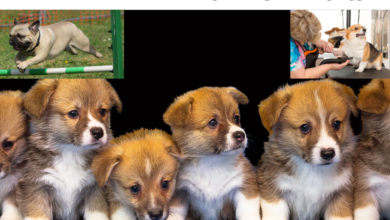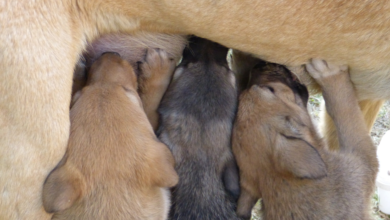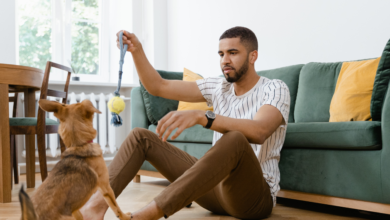
5 Signs Your Dog Loves You
1. Tail Wagging with Enthusiasm
Picture this:
…you walk through the door after a long day, and your furry friend greets you with a tail wagging so vigorously that their whole body seems to wag along with it.
It’s a heartwarming sight, but have you ever wondered what exactly your dog is trying to convey with such enthusiastic tail wagging?
In this illuminating exploration, we’ll unravel the mysteries behind this quintessential canine behavior and uncover how it serves as a powerful indicator of your dog’s deep love and affection for you.
The Science Behind the Wag
At first glance, tail wagging may seem straightforward, but there’s more complexity to it than meets the eye. Researchers have discovered that the direction, speed, and breadth of a dog’s tail wag all carry distinct meanings.
When your dog wags their tail to the right with broad, sweeping motions, it’s a sign of excitement and happiness.
Conversely, a leftward wag may indicate anxiety or uncertainty. By understanding these nuances, you can better interpret your dog’s emotional state and the depth of their affection for you.
The Bonding Power of Tail Wagging
Tail wagging isn’t just a form of communication; it’s also a bonding mechanism between dogs and their human companions.
Studies have shown that dogs wag their tails more frequently and vigorously in the presence of their owners, indicating a strong desire to communicate and connect.
When your dog greets you with an enthusiastic tail wag, they’re not just expressing joy at your return—they’re reaffirming the special bond you share and signaling their love and devotion to you.
Tail Wagging in Context
While tail wagging is often associated with happiness and affection, it’s essential to consider the broader context in which it occurs.
For example, if your dog is wagging their tail while exhibiting other signs of stress or discomfort, such as flattened ears or tense body posture, it may indicate that they’re feeling conflicted or anxious.
By paying attention to your dog’s overall body language and the context in which tail wagging occurs, you can gain deeper insights into their emotional state and respond accordingly with love and understanding.
Reciprocating the Love
Your dog’s enthusiastic tail wagging is a clear expression of their love and devotion to you, but it’s essential to reciprocate that love in return.
Whether it’s through belly rubs, playtime, or simply spending quality time together, nurturing your bond with your furry friend is key to maintaining a strong and loving relationship.
So, the next time your dog greets you with a tail wagging with enthusiasm, take a moment to bask in the warmth of their affection and cherish the unbreakable bond you share.
After all, in the language of dogs, a wagging tail speaks volumes about the depth of their love for you.
In summary:
A wagging tail is often seen as a universal sign of happiness in dogs. But did you know that the way your dog wags their tail can convey different emotions?
A loose, wide wag accompanied by a relaxed body typically indicates pure joy and affection towards you.
2. Gazing into Your Eyes
Have you ever locked eyes with your furry companion and felt an inexplicable connection that transcends words?
It turns out that gazing into your dog’s eyes isn’t just a casual interaction—it’s a powerful form of communication that speaks volumes about the bond you share.
In this enlightening exploration, we’ll delve into the significance of your dog’s gaze and uncover how it serves as a profound expression of love and devotion.
The Power of Eye Contact:
While prolonged eye contact between humans can sometimes be perceived as confrontational, the rules are entirely different in the canine world.
When your dog gazes into your eyes with a soft, unwavering stare, it’s a sign of trust, affection, and intimacy.
Studies have shown that oxytocin, often referred to as the “love hormone,” is released in both dogs and humans during eye contact, strengthening the emotional bond between them.
So, the next time your dog looks deeply into your eyes, know that they’re not just seeing you—they’re connecting with you on a profound level.
The Mirror of the Soul
They say that the eyes are the windows to the soul, and this sentiment rings especially true when it comes to our canine companions.
When your dog gazes into your eyes, they’re not just seeking attention or affection; they’re also revealing their innermost feelings and emotions.
Whether it’s a gentle gaze filled with adoration or a soulful stare brimming with empathy, your dog’s eyes speak volumes about their love for you and their unwavering loyalty as your faithful companion.
Building Trust and Strengthening Bonds
Eye contact isn’t just about communication—it’s also about building trust and strengthening the bond between you and your dog.
When you meet your dog’s gaze with warmth and affection, you’re affirming your connection and reinforcing the foundation of trust that underpins your relationship.
Over time, regular eye contact can deepen your bond with your furry friend, fostering a sense of mutual understanding, respect, and love that transcends words.
Reciprocating the Gaze
Your dog’s loving gaze is a precious gift, and it’s essential to reciprocate it with the same level of love and affection.
Whether it’s through gentle stroking, soothing words, or simply returning their gaze with a warm smile, acknowledging and reciprocating your dog’s loving gaze strengthens the bond between you and reinforces the foundation of trust and love that defines your relationship.
Conclusion:
In the silent language of love, a gaze can speak volumes. So, the next time your dog looks into your eyes with unwavering love and devotion, embrace the moment and cherish the profound connection you share. After all, in the language of dogs, a loving gaze is worth a thousand words.
In summary:
When your dog looks into your eyes with a soft, loving gaze, it’s not just a random occurrence.
Studies have shown that prolonged eye contact releases oxytocin, often referred to as the “love hormone,” in both dogs and humans, strengthening the bond between you and your furry companion.
3. Leaning on You for Comfort
Picture this:
you come home after a long day, feeling weary and exhausted. As you sink into your favorite chair, you feel a familiar weight pressing against your leg.
Looking down, you see your faithful companion, leaning against you for comfort and reassurance.
In this insightful exploration, we’ll uncover the profound significance behind your dog’s instinctual need to lean on you, revealing how it serves as a powerful expression of love and trust.
The Comfort of Proximity:
Dogs are social creatures by nature, seeking comfort and security in the presence of their human companions. When your dog leans against you, they’re not just seeking physical support; they’re also seeking emotional reassurance.
By pressing their body against yours, they’re establishing a sense of closeness and intimacy that strengthens the bond between you.
A Gesture of Trust
Leaning on you is also a sign of trust and vulnerability. Dogs are inherently attuned to their surroundings, and they rely on their human caregivers to provide them with a sense of safety and security.
When your dog leans against you, they’re placing their trust in you to protect and care for them, demonstrating the depth of their love and affection.
Seeking Comfort in Times of Need
Just like humans, dogs experience a range of emotions, including fear, anxiety, and sadness. When your dog leans on you for comfort, it’s often a response to these emotions, seeking solace and reassurance in your presence.
Whether they’re feeling nervous during a thunderstorm or anxious in a new environment, your dog knows that they can find comfort and support by leaning on you.
A Symbol of Affection
Beyond seeking comfort and reassurance, leaning on you is also a gesture of affection and love. Dogs are pack animals, and they form strong emotional bonds with their human family members.
When your dog leans against you, they’re expressing their love and devotion in a tangible and heartfelt way, reminding you of the special bond you share.
Reciprocating the Love
Your dog’s instinctual need to lean on you is a powerful expression of their love and trust. In return, it’s essential to reciprocate that love by providing them with the comfort, support, and reassurance they need.
Whether it’s through gentle petting, soothing words, or simply being present, acknowledging and responding to your dog’s need for comfort strengthens the bond between you and reinforces the foundation of trust and love that defines your relationship.
Conclusion:
In the quiet moments when your dog leans against you for comfort, embrace the opportunity to strengthen the bond you share. By understanding the profound significance behind this instinctual behavior, you can deepen your connection with your furry friend and create moments of intimacy and affection that will last a lifetime. After all, in the language of dogs, a lean is worth a thousand words.
so in summary;
If you noticed your dog leaning against you or snuggling up to you when they’re feeling anxious or unsure…
This behavior is a clear indication of trust and reliance on you for comfort and security.
4. Bringing You Their Favorite Toys or Treats
Imagine this heartwarming scene:
…you’re sitting on the couch, lost in thought, when suddenly, your furry friend trots over with their tail wagging furiously, proudly carrying their favorite toy or treat in their mouth.
In this insightful exploration, we’ll delve into the significance behind your dog’s thoughtful gifts, uncovering how they serve as tangible expressions of love and affection.
The Language of Giving
Gift-giving isn’t just a human custom—it’s also a deeply ingrained behavior in the canine world.
When your dog brings you their favorite toy or treat, they’re not just presenting you with a random object; they’re offering you a piece of their heart.
In the wild, dogs exchange items as a form of social bonding, and this instinctual behavior carries over into their interactions with their human companions.
A Symbol of Trust
When your dog brings you their prized possessions, it’s a powerful display of trust and vulnerability. Dogs are territorial by nature, and they guard their belongings closely.
By offering you their cherished toys or treats, your dog is demonstrating their trust in you and inviting you into their inner circle.
It’s a gesture that speaks volumes about the depth of their love and the strength of your bond.
Sharing Moments of Joy
Beyond trust and vulnerability, your dog’s gifts are also a reflection of their desire to share moments of joy and happiness with you. Dogs are social creatures, and they thrive on positive interactions with their human companions.
When your dog brings you their favorite toy or treat, they’re inviting you to join in the fun and revel in the simple pleasures of playtime or a tasty snack together.
Seeking Approval and Affection
Your dog’s gifts aren’t just about sharing—they’re also a way of seeking approval and affection.
Dogs are incredibly attuned to human emotions, and they crave positive reinforcement from their caregivers.
When your dog presents you with a gift, they’re eagerly awaiting your reaction, hoping for praise, affection, and perhaps even a game of fetch or a shared treat in return.
Reciprocating the Love
Your dog’s thoughtful gifts are a beautiful expression of their love and affection for you. In return, it’s essential to reciprocate that love by acknowledging and appreciating their gestures.
Whether it’s through praise, petting, or engaging in interactive play, taking the time to reciprocate your dog’s gifts strengthens the bond between you and reinforces the foundation of trust, love, and mutual respect that defines your relationship.
Conclusion:
In the language of dogs, a simple gift speaks volumes about the depth of their love and the strength of your bond.
So, the next time your furry friend presents you with their favorite toy or treat, take a moment to cherish the gesture and bask in the warmth of their affection.
After all, in the paws of your beloved companion lies a precious gift—a gift of love that knows no bounds.
Other signs that your Dog loves you you need to know.
5. Following Your Every Move
Understand why your dog shadowing your every step isn’t just about curiosity but also a manifestation of their strong bond with you.
6. Smiling and Playfulness
Explore how dogs express happiness and joy through their playful antics and goofy grins, indicating their delight in your presence.
7. Sleeping Near You
Discover the significance of your dog choosing to sleep close to you, whether it’s at the foot of your bed or snuggled up beside you, as a demonstration of trust and love.
8. Licking Your Face
Decode the meaning behind your dog’s slobbery kisses and face licks, which go beyond simple grooming behavior to convey deep affection and bonding.
9. Mirroring Your Emotions
Understand how dogs are attuned to your emotions and mirror them, offering comfort and support during times of distress or sadness.
Conclusion:
By recognizing and interpreting these ten signs of affection from your dog, you’ll deepen your understanding of the profound bond you share.
Embracing these gestures of love and reciprocating them can strengthen your relationship with your furry companion, making every moment together even more meaningful and fulfilling.
So, the next time your dog gazes into your eyes or wags their tail in delight, remember—it’s their way of saying, “I love you more than anything.”




